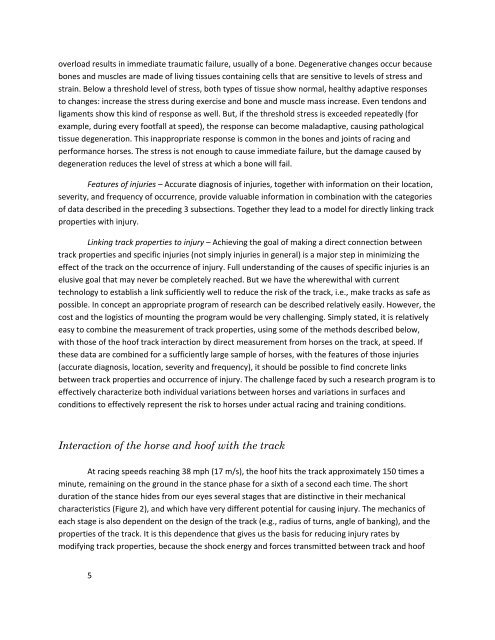Retired Racehorses
tfrr_reportandappendicesfinal
tfrr_reportandappendicesfinal
- No tags were found...
Create successful ePaper yourself
Turn your PDF publications into a flip-book with our unique Google optimized e-Paper software.
overload results in immediate traumatic failure, usually of a bone. Degenerative changes occur because<br />
bones and muscles are made of living tissues containing cells that are sensitive to levels of stress and<br />
strain. Below a threshold level of stress, both types of tissue show normal, healthy adaptive responses<br />
to changes: increase the stress during exercise and bone and muscle mass increase. Even tendons and<br />
ligaments show this kind of response as well. But, if the threshold stress is exceeded repeatedly (for<br />
example, during every footfall at speed), the response can become maladaptive, causing pathological<br />
tissue degeneration. This inappropriate response is common in the bones and joints of racing and<br />
performance horses. The stress is not enough to cause immediate failure, but the damage caused by<br />
degeneration reduces the level of stress at which a bone will fail.<br />
Features of injuries – Accurate diagnosis of injuries, together with information on their location,<br />
severity, and frequency of occurrence, provide valuable information in combination with the categories<br />
of data described in the preceding 3 subsections. Together they lead to a model for directly linking track<br />
properties with injury.<br />
Linking track properties to injury – Achieving the goal of making a direct connection between<br />
track properties and specific injuries (not simply injuries in general) is a major step in minimizing the<br />
effect of the track on the occurrence of injury. Full understanding of the causes of specific injuries is an<br />
elusive goal that may never be completely reached. But we have the wherewithal with current<br />
technology to establish a link sufficiently well to reduce the risk of the track, i.e., make tracks as safe as<br />
possible. In concept an appropriate program of research can be described relatively easily. However, the<br />
cost and the logistics of mounting the program would be very challenging. Simply stated, it is relatively<br />
easy to combine the measurement of track properties, using some of the methods described below,<br />
with those of the hoof track interaction by direct measurement from horses on the track, at speed. If<br />
these data are combined for a sufficiently large sample of horses, with the features of those injuries<br />
(accurate diagnosis, location, severity and frequency), it should be possible to find concrete links<br />
between track properties and occurrence of injury. The challenge faced by such a research program is to<br />
effectively characterize both individual variations between horses and variations in surfaces and<br />
conditions to effectively represent the risk to horses under actual racing and training conditions.<br />
Interaction of the horse and hoof with the track<br />
At racing speeds reaching 38 mph (17 m/s), the hoof hits the track approximately 150 times a<br />
minute, remaining on the ground in the stance phase for a sixth of a second each time. The short<br />
duration of the stance hides from our eyes several stages that are distinctive in their mechanical<br />
characteristics (Figure 2), and which have very different potential for causing injury. The mechanics of<br />
each stage is also dependent on the design of the track (e.g., radius of turns, angle of banking), and the<br />
properties of the track. It is this dependence that gives us the basis for reducing injury rates by<br />
modifying track properties, because the shock energy and forces transmitted between track and hoof<br />
5


